|
Bourne
Wood
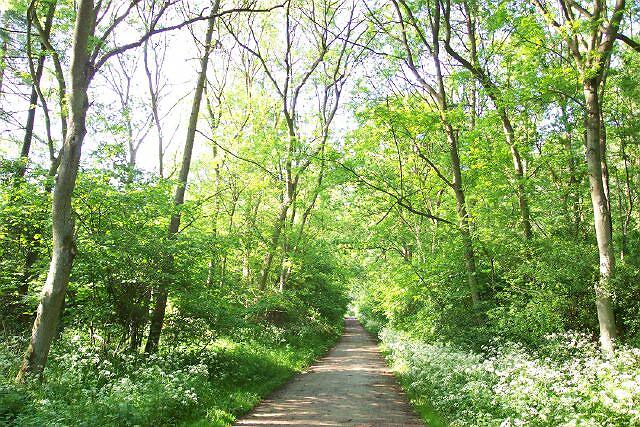
There has probably been continuous tree cover on this site for the last 8,000 years and the present trees are a mixture of broadleaf and conifer of all ages and their diversity has created ideal conditions for a wide range of wildlife. Bourne Wood covers some 400 acres and is now managed for conservation as well as recreation and timber production.
The Forestry Commission bought the larger
part of the wood from the Earl of Exeter, the Lord of the Manor, in 1926 and the timber
brought in an income of 20 shillings per acre per annum, most of it being used for fencing enclosures. In the preceding years, the woods had been heavily felled, most probably to provide props for the trenches during the First World War, and when the commission took over there was an urgent need for extensive re-planting as part of their policy of producing softwoods because the return on them was much quicker.
This policy has since been reviewed and the loss of broad-leaved trees is
being remedied under a new programme of re-establishing the old forest.
Many plants have survived and so make the woodland valuable in terms of wildlife conservation. The wild flowers that can be seen here in season include bluebells, primroses, wood anemone and nettle leaved bell flower while fallow deer are abundant and you may catch a glimpse of their smaller, shy cousin, the muntjac or barking deer. Other animals that can be seen in these glades are foxes, grey squirrels, owls, snakes, badgers and dormice and a wide variety of birds. Nightingales can be heard on summer nights and rare bats and dragonflies fly over the ponds at twilight. Seven
species of bat have also been identified including the rare Leisler's bat which
was first discovered in nesting boxes in 1991 and is now being closely monitored
by the Forestry Commission in conjunction with English Nature.
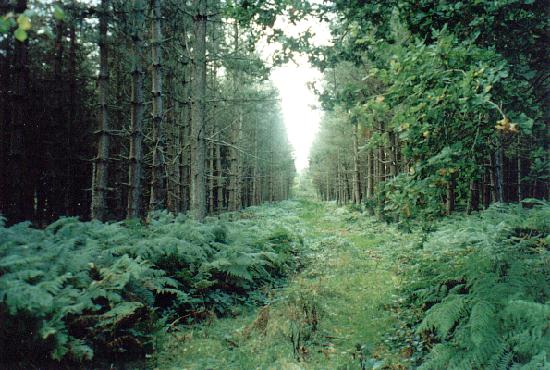
One of the delights of walking in the woods is to explore the many tracks that lead off the main paths for there is always something new to discover. The
ancient forest that can be found here consists of mixed plantings of both deciduous and coniferous trees and each have their own beauty. The Corsican pines that can be seen here were once native to that Mediterranean island of high granite peaks and fertile plains but have been grown in Britain since 1814 and are now reared at nurseries in this country before being planted out and these will be thinned once every five years before a final crop of around 100 trees are felled perhaps 20 years from now. In the meantime, these magnificent trees that can attain heights of 150 feet, are here for us to enjoy throughout the
year for as every schoolboy knows, they will remain evergreen because conifers do not shed their leaves in winter.
Deep in the woods are two ponds which were made by damming a small dip in the landscape in 1972 and these have become watering holes for woodland inhabitants and home to ducks, herons, many aquatic animals and several species of fish. They
have become a mass of rushes and sedge, white water lilies float on the surface and yellow flag grows in the margins of the lakes while fallow deer come to drink here in the evenings and early mornings and their hoof prints can often be seen in the soft mud at the water's edge. This is a marvellous sight if you are prepared to sit here until dusk or to get up at 4 a m on a summer's morning for a rendezvous with these graceful creatures.
|
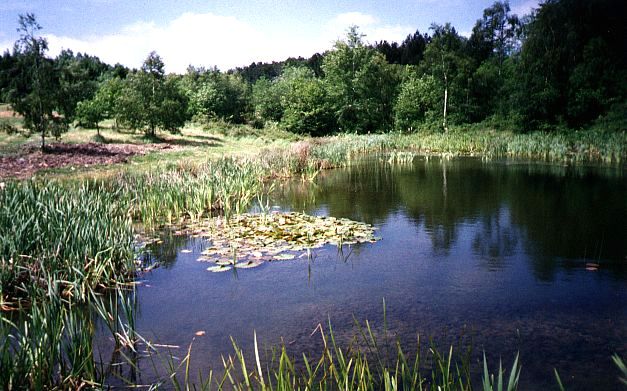
One
of the two lakes, deep in the woods |
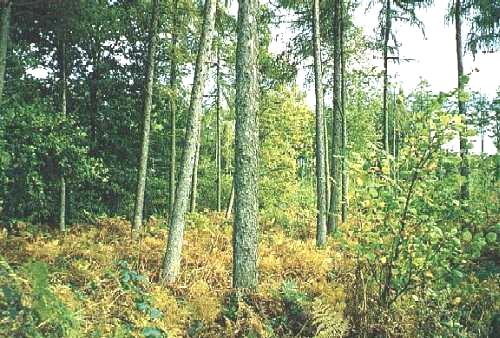
The
woods in autumn, a magical time |
An endearing feature introduced in Bourne Wood by the Forestry Commission in recent years is the placing of memorial seats at suitable locations alongside the footpaths to enable older walkers sit and take a rest. These rustic seats have been made by staff on site from timber grown in the woods and financed by relatives of loved ones now dead who enjoyed walking here while small metal plaques record their dedication.
|
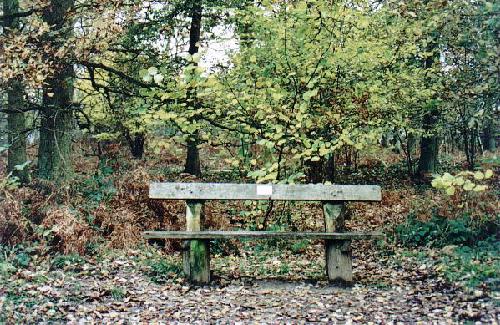 |
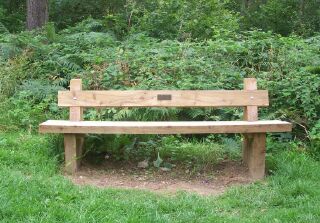 |
|
Rustic
seats have been a feature of the woods in recent years, placed alongside the main paths
to provide a place to rest for those with aching legs and to
remind us of others who walked here in the past. The memorial
brass plate on this seat (left) is to the memory of Ted Armstrong and his
dog Snoopy who were frequent visitors before he died in 1990.
These seats were however prone to vandalism, despite the poignancy
of their dedications, and in 2002, the Forestry Commission
replaced them with sturdier constructions (right) but only time
will tell if they can withstand the assaults of those who only
wish to destroy what other people regard as sacrosanct. |
One poignant inscription reminds us of the deep affection felt by those who have enjoyed this amenity just a short distance from the town centre and which attracts more than 100,000 visitors a year and it can be found on a seat by the main footpath: "In loving memory of Ted Armstrong 1916-1990 who walked daily in these woods he loved with his dog Snoopy." We always sit on this seat for a few moments when walking these paths because we remember this man and his dog and to see him stepping out on an autumn day was to share with him the deep affection that he had for this place and long may these woods survive to give similar pleasure to those who come here.
|
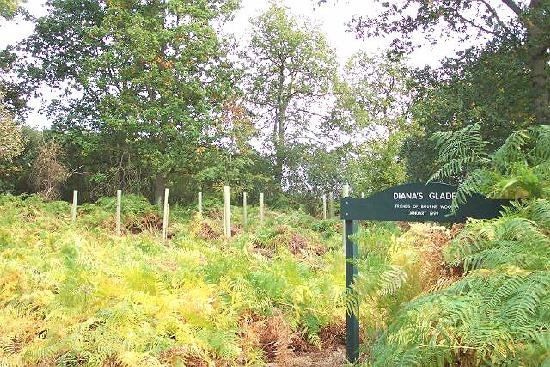 |
|
Twenty small oak
trees were planted here in January 1999 by the Friends of Bourne
Wood organisation as a tribute to Diana, Princess of Wales, who
died tragically in 1997, and the spot was named Diana's Glade. |
|
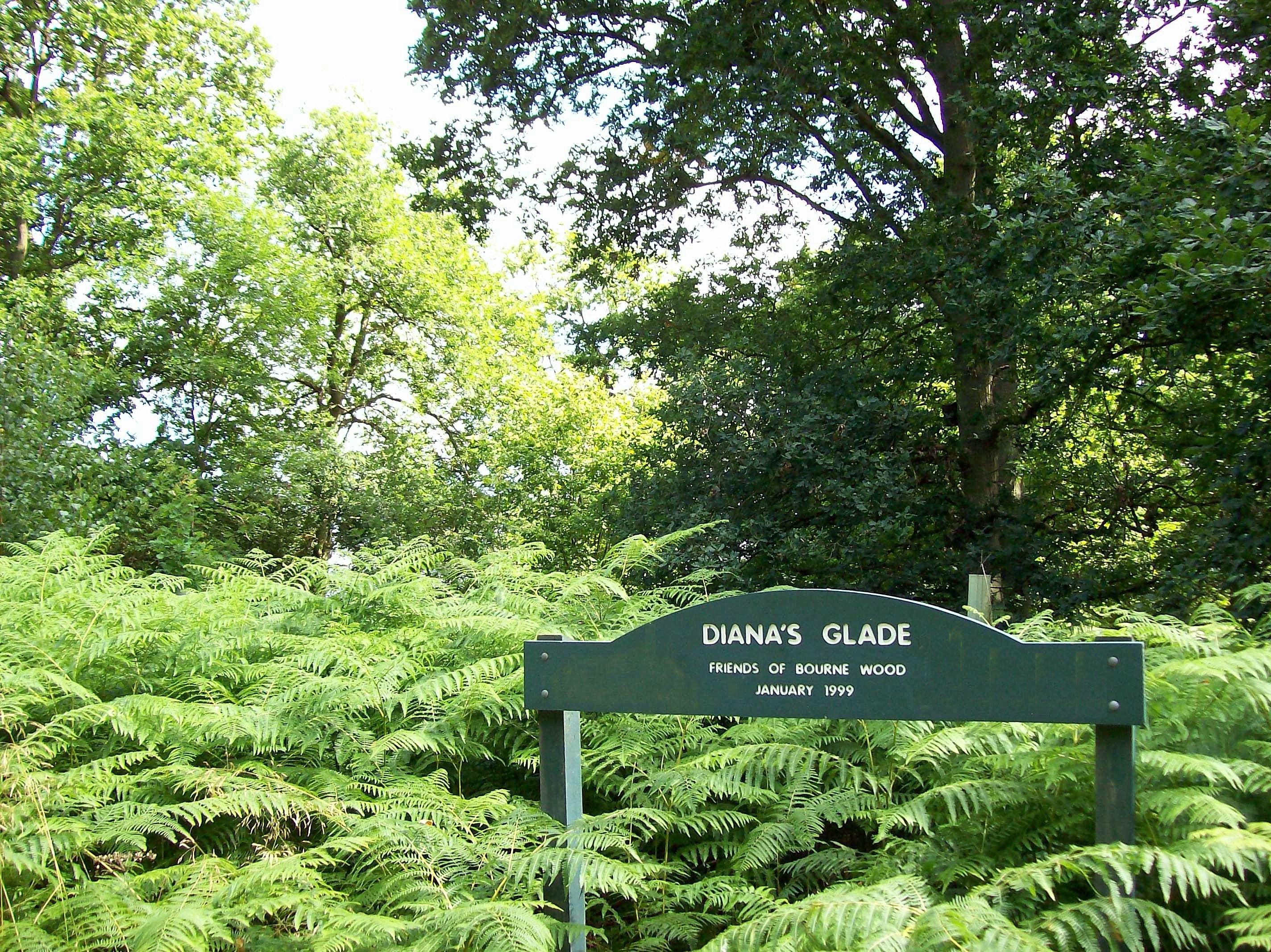 |
|
THE WOODLAND TRAILS |
|
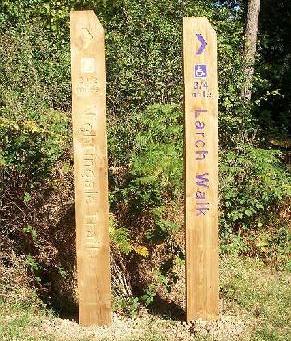 |
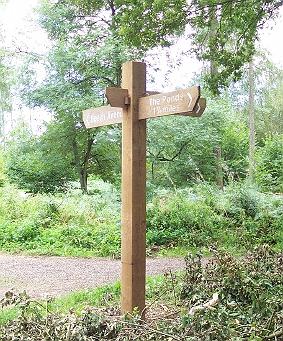 |
|
New woodland trails were introduced in the
autumn of 2003 with the intention of directing visitors to the most
attractive areas of the forest. Their names are self-explanatory but
the most appealing is the Nightingale Trail, dedicated to one of
Britain's rarest and most beautiful songbirds that can be found
here.
The trail runs for a distance of 2½
miles and can be followed by the orange-lettered markers. Forester
John Wilcockson is particularly enthusiastic. "No one who has ever
listened to the nightingale can forget its magical melodies", he
said. "The trail has been planned to take visitors right into those
parts of the woodland where the birds are most likely to be heard
singing although the bird is elusive and sightings are less likely."
The number of nightingales in Bourne Wood declined during the latter
half of the 20th century but the Forestry Commission has set up a
special management programme to create more suitable habitats.
During the summer the following year, new signposts were erected at
various vantage points throughout the wood to help the growing
number of visitors find their way along the main paths and, more
particularly, the way back to the car park. |
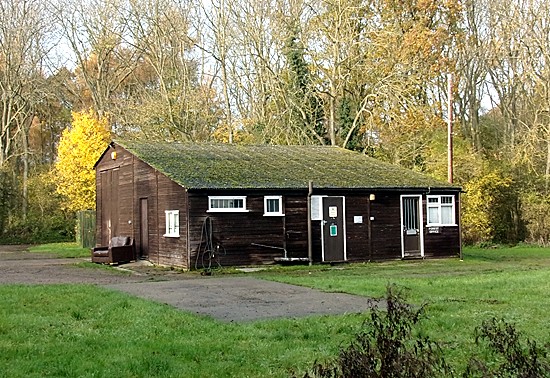 |
|
The woodmen's hut at the Beech Avenue entrance which
is used as office, rest room and workshop by staff from the Forestry
Commission who
administer the woods. |
|
FROM THE ARCHIVES |
|
BOURNE WOOD: The inhabitants of Bourne have in these
woods a never-failing store of "musical instruments". In the early morning
and during the greater part of the day the air is filled with the voices
of hundreds of songsters; but the masterpiece may be heard in the evening,
when large numbers of nightingales take up the song uninterrupted. Bourne
Wood is a favourite resort of these princes among birds, but the numbers
this spring are extraordinary; their beautiful strains must be heard to be
believed. - news item from the Grantham Journal, Saturday 2nd May 1874.
THE WEATHER: Spring appears to have set in very fine, but dry. Several
days indeed have been of almost summer temperature. The cuckoo has been
heard in the neighbourhood, and a pair of swallows were observed in the
town in the early part of the week. Bourne Wood is resorted to daily;
their appearance is highly picturesque, and the air is filled with the
strains of a thousand songsters. - news item from the Grantham Journal,
Saturday 24th April 1875.
SCHOOL TREAT: On Wednesday last, the children attending the Wesleyan
Sunday School were provided with a tea in Bourne Woods, and being joined
by large numbers of all ages in the evening, a pleasant time was spent. J
L Bell Esq., kindly lent his field adjoining the woods, where various
sports were held.
- news item from the Grantham Journal, Saturday 14th July 1877.
SALE BY AUCTION - BOURNE WOOD: Messrs Richardson have received
instructions to sell by auction on Wednesday the 8th day of October, 367
oak timber trees and saplings, 8 lots of collars, 5,000 faggots, and a
quantity of firewood, now numbered in Bourne Wood. The Sale will commence
with Lot 1 in Bourne Wood, near the town, and within a short distance of
Bourne Railway Station, at eleven for twelve o'clock. Catalogues may be
obtained of Mr Charles Thorpe, Burghley Office, Stamford, and of Messrs
Richardson, auctioneers and valuers, Stamford, or will be forwarded free
upon application. Mr James Featherstone, West Street, Bourne, will, upon
application, show the wood. - sales notice in the Lincolnshire
Chronicle, Friday 3rd October 1884.
A STRAYED HEIFER: A heifer, formerly the property of Mr Richard Falkner
[farmer and market gardener, of Eastgate], has strayed away into Bourne
Wood, where it has been roaming at large for about five weeks. It is
becoming quite ferocious. Attempts to capture it have up to the present
been unsuccessful. It has, we understand, been recently purchased by Mr
Henry Hardwicke [cattle dealer]. - news item from the Grantham
Journal, Saturday 17th September 1887.
PICNIC IN BOURNE WOOD: The Rev John Woollerton who for three years has
held the Wesleyan circuit in this town, leaves in a fortnight to undertake
the circuit at Market Rasen. Much regret is felt at his departure. The
members of the Mutual Improvement Society, of which Mr Woollerton has been
president, wished to hold a farewell gathering and it was decided a few
weeks ago that a picnic would be the most enjoyable form of entertainment,
provided the weather was favourable. This at the time appeared doubtful,
but on the day selected, Friday August 10th, the weather was splendid. In
the open fields the sun was too hot, but this only rendered the shade of
the wood more delightful. The pioneers of the party arrived at about
three. Mr Stanton undertook the convoy of the provisions and apparatus,
and on their arrival the gentlemen of the party built fires on which
immense kettles were boiled in an incredibly short time, while the ladies
laid out the cloths, and spread a bountiful meal, to which about sixty sat
down. The garden party at the Vicarage was the cause of the absence of
others who were expected. After tea, the members of the Society were
photographed by Mr [Richard] Bertolle, and the party then either strolled along the
shaded ridings or joined in various games till about eight o'clock when
refreshment was provided. After this, the Rev J Woollerton proposed a vote
of thanks to those ladies and gentlemen who had carried out the
arrangements for the picnic. This was carried enthusiastically. The party
started for home at about nine o'clock, one and all expressing the
pleasure the outing had afforded. - news report from the Grantham
Journal, Saturday 18th August 1888. |

Go to:
Main Index
|









